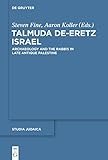Talmuda de-Eretz Israel : Archaeology and the Rabbis in Late Antique Palestine / ed. by Steven Fine, Aaron Koller.
Material type: TextSeries: Studia Judaica : Forschungen zur Wissenschaft des Judentums ; 73Publisher: Berlin ; Boston : De Gruyter, [2014]Copyright date: ©2014Description: 1 online resource (352 p.)Content type:
TextSeries: Studia Judaica : Forschungen zur Wissenschaft des Judentums ; 73Publisher: Berlin ; Boston : De Gruyter, [2014]Copyright date: ©2014Description: 1 online resource (352 p.)Content type: - 9781614514855
- 9781614518518
- 9781614512875
- 296.1/24067 23
- BM496.6
- online - DeGruyter
- Issued also in print.
| Item type | Current library | Call number | URL | Status | Notes | Barcode | |
|---|---|---|---|---|---|---|---|
 eBook
eBook
|
Biblioteca "Angelicum" Pont. Univ. S.Tommaso d'Aquino Nuvola online | online - DeGruyter (Browse shelf(Opens below)) | Online access | Not for loan (Accesso limitato) | Accesso per gli utenti autorizzati / Access for authorized users | (dgr)9781614512875 |
Browsing Biblioteca "Angelicum" Pont. Univ. S.Tommaso d'Aquino shelves, Shelving location: Nuvola online Close shelf browser (Hides shelf browser)

|

|

|

|

|

|

|
||
| online - DeGruyter The Nominal Structure in Slavic and Beyond / | online - DeGruyter Current Multilingualism : A New Linguistic Dispensation / | online - DeGruyter Constructing the Heritage Language Learner : Knowledge, Power and New Subjectivities / | online - DeGruyter Talmuda de-Eretz Israel : Archaeology and the Rabbis in Late Antique Palestine / | online - DeGruyter Ancient Greek Dialects and Early Authors : Introduction to the Dialect Mixture in Homer, with Notes on Lyric and Herodotus / | online - DeGruyter Religious Publishing and Print Culture in Modern China : 1800-2012 / | online - DeGruyter The Peoples of Ancient Italy / |
Frontmatter -- Preface -- Contents -- Mishnah Baba Metsia 7:7 and the Relationship of Mishnaic Hebrew to Northern Biblical Hebrew -- Mishnah Baba Batra 8:5 – The Transformation of the Firstborn Son from Family Leader to Family Member -- Mishnah Avodah Zarah 4:5 – The Faces of Effacement: Between Textual and Artistic Evidence -- Tosefta Ma‘aser Sheni 1:4 – The Rabbis and Roman Civic Coinage in Late Antique Palestine -- Tosefta Shabbat 1:14 – “Come and See the Extent to Which Purity Had Spread” An Archaeological Perspective on the Historical Background to a Late Tannaitic Passage -- An Illustrated Midrash of Mekilta de R. Ishmael, Vayeḥi Beshalaḥ, 1 – Rabbis and the Jewish Community Revisited -- Jerusalem Talmud Megillah 1 (71b–72a) – “Of the Making of Books”: Rabbinic Scribal Arts in Light of the Dead Sea Scrolls -- Jerusalem Talmud Sanhedrin 2,6 (20c) – The Demise of King Solomon and Roman Imperial Propaganda in Late Antiquity -- Genesis Rabbah 1, 1 – Mosaic Torah as the Blueprint of the Universe – Insights from the Roman World -- Genesis Rabbah 98, 17 – “And Why Is It Called Gennosar?” Recent Discoveries at Magdala and Jewish Life on the Plain of Gennosar in the Early Roman Period -- Leviticus Rabbah 16, 1 – “Odysseus and the Sirens” in the Beit Leontis Mosaic from Beit She’an -- Babylonian Talmud, Sukkah 51b – Coloring the Temple: Polychromy and the Jerusalem Temple in Late Antiquity -- Babylonian Talmud, Avodah Zarah 16a – Jews and Pagan Cults in Third-Century Sepphoris -- The Rehov Inscriptions and Rabbinic Literature – Matters of Language -- “This Is the Beit Midrash of Rabbi Eliezer ha-Qappar” (Dabbura Inscription) – Were Epigraphical Rabbis Real Sages, or Nothing More Than Donors and Honored Deceased? -- The Piyyutim le-Hatan of Qallir and Amittai – Jewish Marriage Customs in Early Byzantium -- Afterwords -- The Use of Archaeology in Understanding Rabbinic Materials: An Archaeological Perspective -- The Use of Archaeology in Understanding Rabbinic Materials: A Talmudic Perspective -- Index
restricted access online access with authorization star
http://purl.org/coar/access_right/c_16ec
Talmuda de-Eretz Israel: Archaeology and the Rabbis in Late Antique Palestine brings together an international community of historians, literature scholars and archaeologists to explore how the integrated study of rabbinic texts and archaeology increases our understanding of both types of evidence, and of the complex culture which they together reflect. This volume reflects a growing consensus that rabbinic culture was an “embodied” culture, presenting a series of case studies that demonstrate the value of archaeology for the contextualization of rabbinic literature. It steers away from later twentieth-century trends, particularly in North America, that stressed disjunction between archaeology and rabbinic literature, and seeks a more holistic approach.
Issued also in print.
Mode of access: Internet via World Wide Web.
In English.
Description based on online resource; title from PDF title page (publisher's Web site, viewed 28. Feb 2023)


